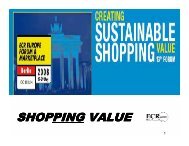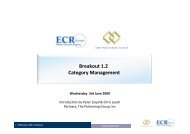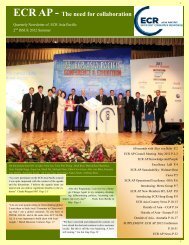You also want an ePaper? Increase the reach of your titles
YUMPU automatically turns print PDFs into web optimized ePapers that Google loves.
Figure 20: Cumulative module usage and recommendation<br />
The following recommendations clearly differentiate<br />
between spaces made available in the supply chain for<br />
secondary unit loads and secondary unit loads which<br />
make optimal use of these spaces. Hereby, space refers<br />
to the plan dimension or surface area and not to the<br />
cubic capacity or volume (see Appendix 10.3).<br />
Recommendations<br />
• Spaces made available should be based on the<br />
600x400 master module. This adds up to a<br />
total of five modular dimensions: 1200x800,<br />
800x600, 600x400, 400x300 and 300x200 mm<br />
• The height of secondary unit loads is left up to<br />
the discretion of the user but should be<br />
derived in a modular form from the maximum<br />
stacking heights of tertiary unit loads.<br />
Additional Guidelines<br />
• If secondary unit loads cannot be designed in<br />
accordance with the above plan dimensions,<br />
they should fit the modular tertiary space<br />
• The plan dimensions 1200x1000, 400x200 and<br />
300x100 mm are also recognised. The first is<br />
further covered in Chapter 7 – Tertiary Items.<br />
• Primary products should be adapted to reflect<br />
modularity, subject to market requirements<br />
• No plus tolerance is allowed. Fully loaded<br />
secondary unit loads, including bulging, as a<br />
result of other loads stacked on them, may not<br />
exceed the designated modular space.<br />
Such an approach is contrary to the current practice, in<br />
which packaging is designed primarily to protect<br />
primary products. In order to follow these<br />
recommendations, it will be necessary to adapt primary<br />
product dimensions to best utilise modular secondary<br />
and/or tertiary space available, and to review order<br />
quantities.<br />
34<br />
ISO modular system<br />
% volume Average surface<br />
impact utilisation<br />
7 top 7 ISO 90% 71.1%<br />
18 remaining 10% 64.4%<br />
25 total (all dimensions) 100% 71%<br />
7 recommended modules 100% 69%<br />
Source: A.T. Kearney, Efficient Unit Loads project<br />
To optimally use modular secondary spaces,<br />
primary product dimensions have to be reviewed<br />
and replenishment quantities and case count<br />
reconsidered.<br />
A manufacturer in the EUL team: “From our<br />
analysis, we have discovered that we can improve<br />
pallet utilisation by seven to ten percent, by<br />
introducing only minor (less than 1 cm) changes to<br />
our primary pack sizes – and we have already<br />
started doing it!”<br />
5.3. Handling Efficiency<br />
The main difference between handling at the factory<br />
(packing and palletising) and in the store (unpacking<br />
and shelf replenishment) lies in the degree of<br />
automation. Handling at the plant is often highly<br />
automated, dealing with a limited range of secondary<br />
unit loads, at a low handling cost per unit. In contrast,<br />
shelf replenishment is a manual operation, handling a<br />
wide variety of secondary unit load types, which are<br />
costly per unit. Although both operations will benefit<br />
from improved harmonisation of secondary unit loads,<br />
the shelf replenishment process is of special interest.<br />
According to estimates provided by the EUL team,<br />
shelf replenishment on average amounts to 1.7<br />
percent of the retail sales price.<br />
Currently there is often a duplication in handling as primary<br />
packs are placed into secondary packaging by the<br />
manufacturer, then taken out again by the retailer before<br />
going on the shelf. The cost of packaging must be<br />
considered in addition to the handling cost. Eliminating one<br />
of these two handling steps should be a priority within EUL.<br />
There is considerable potential in placing the secondary<br />
unit load on the shelf as a display item since this<br />
eliminates most primary handling. Secondary unit loads<br />
serving as display items should have an attractive<br />
appearance and allow easy consumer access.<br />
The Efficient Unit Loads Report










